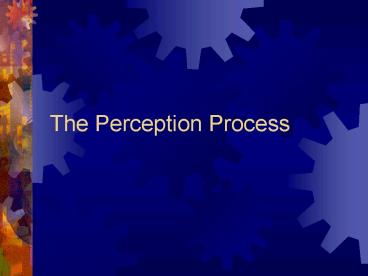The Perception Process - PowerPoint PPT Presentation
1 / 14
Title:
The Perception Process
Description:
Constructivism theory. Cognitive schemata. Prototypes. Personal Constructs. Stereotypes ... Knowledge structures that define the most representative example of ... – PowerPoint PPT presentation
Number of Views:65
Avg rating:3.0/5.0
Title: The Perception Process
1
The Perception Process
2
Process of Perception
- Selecting
- Organizing
- Interpreting
3
Selection
- We choose to attend to only some stimuli
- Qualities which capture us
- Outstanding, large
- Intensity
- Unusual
4
Organizing Constructivism theory
- Cognitive schemata
- Prototypes
- Personal Constructs
- Stereotypes
- Scripts
5
Prototypes
- Knowledge structures that define the most
representative example of some category - A is the ideal friend
- B is the great teacher
6
Personal Constructs
- Mental yardsticks formed as a bi-polar scale of
judgment - Smart.dumb
- Attractive.Unattractive
- Interesting.Uninteresting
7
Difference between the two
- Prototype - put in broad category
- Personal construct - a detailed assessment
8
Stereotypes
- We predict that a person will behave according to
the prototype and personal construct weve made. - Really, a predictive generalization because of
the category and measurement weve made.
9
Scripts
- The sequence of activities we expect to follow in
particular situations - Casual greeting
- Job interview
- At a funeral
- On a first date
10
Interpretation
- The subjective process of creating explanations -
meaning - for the messages we receive. - Attributions (the why?)
- Locus INTERNAL -EXTERNAL
- Stability STABLE - UNSTABLE
- Controllability ABLE TO - NOT ABLE TO
11
A took a wallet out of the purse
- Locus INTERNAL -EXTERNAL
- Stability STABLE - UNSTABLE
- Controllability ABLE TO - NOT ABLE TO
12
Phenomenon of Self-Serving Bias
- Internal and stable attributions that we control
WHEN SUCCESSFUL - External and unstable attributions not under our
control WHEN NOT SUCCESSFUL
13
Influences on Perception
- Physiological Factors
- Expectations
- Cognitive Abilities
- Social Roles
- Cultural Factors
14
END
- Based on Julia Woods Communication Mosaics,
Chapter 2 Perceiving and Understanding































